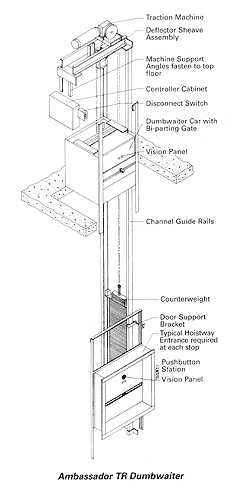Vertical Materials Handling Systems aka Dumbwaiters
Selecting one with a winding drum mechanism-the smallest and simplest available-the firm created a gypsum wallboard type shaft, which required code compliance just as with a stair or elevator application. Since the old wood flooring was being replaced, there was minimal impact on the structural design of the floors. Because access to the machine was placed at the lowest level opening instead of above the car, a fire rated access door was required. Crouch points out the importance of having the controls and bottom of the opening accessible for people with handicaps.
|
Dumbwaiter Speeds, Capacity and Travel Limitations
|
||||||||||||||||||||
The Planning Process
While each project is unique, the planning process for specifying dumbwaiter systems includes the same key decisions. There is a logical order to the process, but building constraints such as the space available above the car on the upper landing, may dictate the choice of lift. Fortunately for those familiar with the former MasterFormat numbering system, there is little new to learn in the new MasterFormat 2004 Edition. All Conveying Equipment remains in Division 14 with Conveying Equipment assigned to 14 00 00 and Dumbwaiters assigned to 14 10 00.
|
The planning steps are:
- Determine whether the dumbwaiter will stop at floor level or counter height.
- Note hoistway or shaft clearances (Diagram A).
- Determine space requirement above the car at the upper landing.
- Determine the limitations of travel and speed according to the project requirements.
A rule of thumb for selecting speed requirement for medium and high-rise applications: the traveling time between terminal landings should never exceed 30-45 seconds.
On speeds exceeding 100 feet per minute, variable voltage equipment will often be required.
- Determine whether guide rails should be bracketed to the walls and floor slabs (required load-bearing or reinforced hoistway walls) or furnished with a full, self-supporting, angle tower, permitting use of less expensive wall construction. (Most local building codes require shaft walls to have a two-hour fire rating.)
- Determine machine location. Traction dumbwaiter machines are usually located at the top. Machines for winding drum floor loading dumbwaiters are commonly located at the top, but with a counter-height loading model, they may be placed in the hoistway below the counter-height. In special situations such as clean rooms, machines for both winding drum and traction type dumbwaiters may be located at lower landings at either side of the hoistway
- Select lift model.










